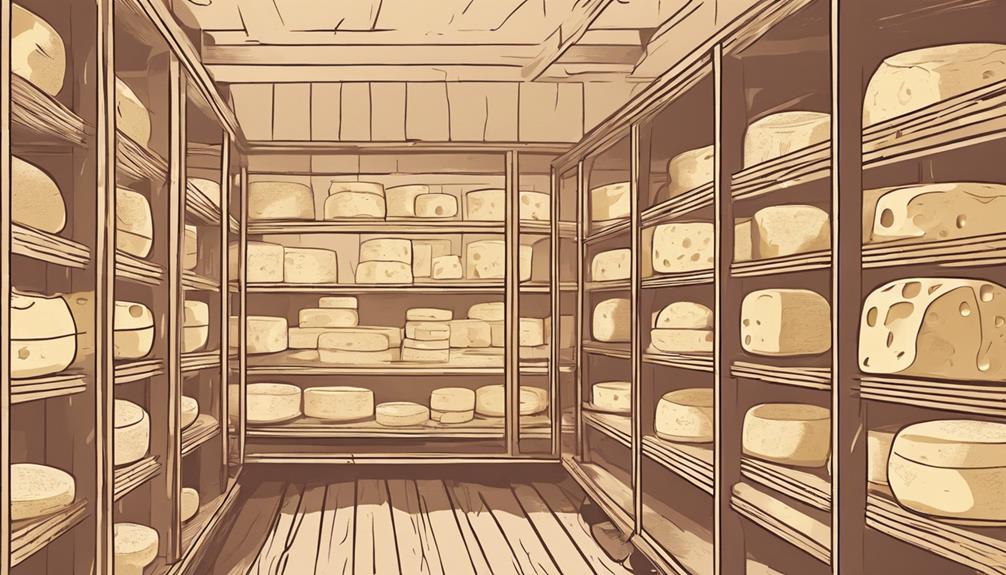How To Become More Self-Sufficient Without Starting a Full-Blown Farm…
Want to start preserving your harvest, making your own soap, or building a backyard root cellar — but not sure where to begin? “Homesteading Advice” gives you instant lifetime access to 35+ practical homesteading books on food preservation, veggie gardening, DIY natural cleaning products (save over $250 per year with this skill alone), brewing, off-grid energy, and a whole lot more…
Click Here To Check It Out Now!
“I’ve been making cheese for a couple of years now and I’m starting to age my own wheels. Last month, I noticed some unwanted mold growth on a batch of cheddar and had to discard it. It was a huge setback. Now I’m a bit wary about aging more cheese without proper precautions. What are the best ways to prevent unwanted mold growth during the aging process? I’ve got a small cheese cave set up in my basement. Any tips to ensure this doesn’t happen again?” Thanks, Gregory, Seattle, USA.
How to Prevent Unwanted Mold Growth During Aging
Aging cheese can be a rewarding yet challenging aspect of cheese making. It requires attention to detail and the right conditions to achieve the desired flavor and texture while avoiding unwanted problems like mold growth. Let’s discuss the steps to help prevent unwanted mold while aging your cheese, Gregory.
Understanding the Environment
The environment in which cheese ages plays a crucial role in its overall quality. Factors such as humidity, temperature, and air quality need to be carefully controlled. Unwanted mold thrives in environments that are warm, damp, and dark. To counteract this, maintaining an optimal environment is essential.
Humidity Control
Humidity is a significant factor in mold growth. Cheeses generally require a humidity level of 80-90% for proper aging, but live spores can thrive in higher humidities if not controlled properly. Here are some tips to manage humidity:
- Use a Humidity Gauge: Regularly monitor the humidity levels in your cheese cave using a reliable hygrometer. This will help you keep track and adjust as necessary.
- Dehumidifiers: If the humidity is too high, consider using a dehumidifier to bring it down to the optimal level.
- Hydration Pads: For maintaining appropriate humidity, use hydration pads or containers with water placed inside the cave. Just make sure they are sanitized and checked regularly.
Temperature Management
Temperature control is equally vital as it influences both the cheese’s ripening process and the risk of mold development. Aim to keep your aging space within the range of 50-55°F. However, specific types of cheese might have varying requirements:
- Thermometers: Use digital thermometers that provide accurate and constant readings of the cave’s temperature.
- Cooling Units: A small air conditioner or dedicated wine cooler can be used to maintain consistent temperatures.
- Air Flow: Ensure proper ventilation and air flow to prevent stagnant air pockets which can foster mold growth.
Cleaning and Sanitation
Kitchens and aging spaces can often harbor bacteria and mold spores. Implementing rigorous cleaning and sanitization routines will minimize the risk significantly:
- Regular Cleaning: Clean your cheese cave and all equipment thoroughly before and after use. This includes shelves, containers, and any tools or utensils.
- Sanitizing Solutions: Use a mixture of white vinegar and water or a commercial cheese-safe sanitizer to clean surfaces regularly.
- Hand Hygiene: Always wash and sanitize your hands before handling cheeses to avoid introducing unwanted bacteria or mold spores.
Cheese Coatings and Treatments
Protective coatings can shield your cheese from unwanted molds. Here are common options:
- Wax Coating: Traditional methods include waxing cheese, which creates a barrier to external mold spores. Ensure the wax is food-grade.
- Natural Rind Treatment: For natural rinds, regularly brushing or washing the rinds with a salt brine or acidic solution (such as vinegar) can deter mold growth.
- Coat with Butter or Oil: A thin layer of butter or olive oil can also act as a protective barrier.
Monitoring and Maintenance
Regularly checking on your aging cheeses and taking action at the first signs of unwanted mold is critical:
- Inspect Weekly: Make weekly checks on each wheel for any signs of unwelcome mold or imperfections.
- Remove Unwanted Mold: Carefully scrape off any unwanted mold with a clean cheese brush or cloth, and treat the area with a gentle vinegar solution.
- Document Observations: Keep a detailed log of observations including date, type of cheese, and any actions taken. This can help identify patterns or recurring issues.
Using Cultures and Mold Inhibitors
Cheese cultures and specific mold inhibitors can help in regulating the types of molds that are present during aging:
- Starter Cultures: Use specific cultures that promote desired bacterial growth which can outcompete unwanted mold.
- Nisin: This natural preservative, often added to cheese, can inhibit the growth of undesirable bacteria and molds.
Common Problems and Solutions
Even with the best practices, issues can still arise. Here are some common mold-related problems and potential solutions:
| Issue | Solution |
|---|---|
| Blue or Green Mold | Scrape off mold and apply a salt solution to the affected area. |
| Strong Odors | Ensure proper air flow and consider using activated charcoal to absorb odors. |
| Skin or Rind Separation | Maintain proper humidity and avoid handling the cheese excessively during the early aging stages. |
Final Thoughts…
Gregory, preventing unwanted mold growth during cheese aging requires a combination of environmental control, regular maintenance, and vigilant monitoring. By implementing these strategies, you can create an ideal environment that promotes the healthy aging of your cheese while minimizing the risk of unwanted mold. Thanks for sharing your experience and best of luck with your cheese aging journey!

